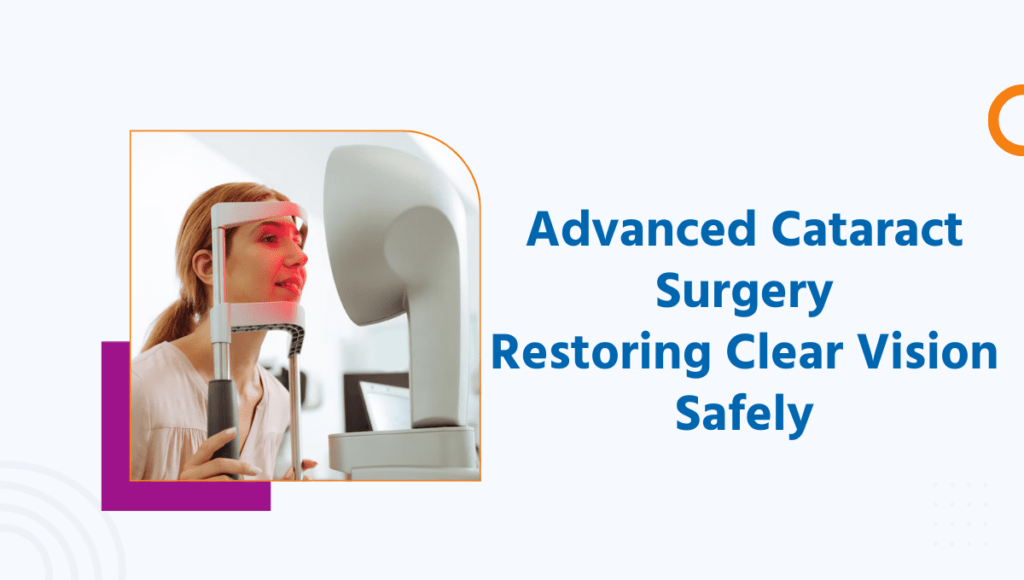Cataracts are a common eye condition, especially among older adults, where the eye’s natural lens becomes cloudy, leading to blurred vision. If left untreated, cataracts can cause significant vision loss. Fortunately, modern medical advancements have made cataract treatment safe, effective, and accessible. This guide covers everything you need to know about cataracts, including symptoms, diagnosis, treatment options, and recovery.
What Are Cataracts?
A cataract occurs when proteins in the eye’s lens break down and clump together, causing cloudiness. This prevents light from passing clearly through the lens, resulting in blurry or dim vision. Cataracts develop slowly and can affect one or both eyes.
Common Causes of Cataracts:
- Aging (most common cause)
- Diabetes
- Prolonged UV exposure
- Smoking
- Eye injuries
- Long-term steroid use
- Genetic factors
Symptoms of Cataracts
Recognizing early symptoms can help in timely treatment. Common signs include:
- Blurry or foggy vision
- Difficulty seeing at night
- Sensitivity to light and glare
- Fading or yellowing of colors
- Frequent changes in eyeglass prescription
- Double vision in one eye
If you experience these symptoms, consult an eye specialist for diagnosis. Early detection can prevent severe vision loss.
Diagnosis of Cataracts
An ophthalmologist conducts a thorough eye exam to diagnose cataracts, which may include:
- Visual Acuity Test – Measures clarity of vision.
- Slit-Lamp Examination – Examines the cornea, iris, and lens under magnification.
- Retinal Exam – Checks the retina after dilating the pupils.
- Tonometry – Measures eye pressure to rule out glaucoma.
Based on the diagnosis, the doctor will recommend the best treatment option.
Cataract Treatment Options
1. Early-Stage Management
In the initial stages, stronger glasses, anti-glare sunglasses, or brighter lighting may help. However, cataracts worsen over time, and surgery is the only permanent solution.
2. Cataract Surgery
When cataracts interfere with daily activities, surgery is recommended. Modern cataract surgery is quick, safe, and highly effective.
Types of Cataract Surgery:
-
Phacoemulsification (Phaco Surgery) – The most common method where ultrasound waves break the cloudy lens, which is then removed and replaced with an artificial lens (IOL).
-
Extracapsular Cataract Extraction (ECCE) – Used for advanced cataracts where the lens is removed in one piece.
-
Laser-Assisted Cataract Surgery – A precise, bladeless procedure using a femtosecond laser.
Intraocular Lenses (IOLs) – Choosing the Right One
During surgery, the natural lens is replaced with an artificial intraocular lens (IOL). Different types include:
- Monofocal IOLs – Corrects distance vision (reading glasses may still be needed).
- Multifocal IOLs – Provides clear vision for both near and far distances.
- Toric IOLs – Corrects astigmatism.
Your doctor will help choose the best IOL based on your lifestyle and vision needs.
Recovery After Cataract Surgery
Cataract surgery is usually an outpatient procedure with minimal downtime. Here’s what to expect:
Post-Surgery Care:
- Use prescribed eye drops to prevent infection.
- Avoid rubbing or pressing the eye.
- Wear protective eyewear, especially while sleeping.
- Avoid strenuous activities for a few weeks.
- Attend follow-up visits as scheduled.
Most patients notice improved vision within a few days, with full recovery in about a month.
Why Choose India for Cataract Treatment?
India is a leading destination for high-quality, affordable eye care. With advanced technology and skilled surgeons, patients receive world-class cataract treatment in India at a fraction of the cost compared to Western countries. For those seeking specialized care, a renowned Eye Clinic in Goa offers expert ophthalmologists and state-of-the-art facilities.
Preventing Cataracts
While aging is inevitable, certain measures can delay cataract formation:
- Wear UV-protected sunglasses.
- Maintain a diet rich in antioxidants (leafy greens, fruits).
- Quit smoking and limit alcohol.
- Control diabetes and blood pressure.
- Get regular eye check-ups after age 40.
Conclusion
Cataracts are a leading cause of vision impairment but are entirely treatable with timely surgery. Advances in medical technology have made cataract procedures safe, quick, and highly effective. If you or a loved one is experiencing vision problems, consult an eye specialist immediately. Early intervention can restore clear vision and improve quality of life.
For expert care, consider visiting a trusted eye clinic in India, where advanced cataract treatment in India is available with excellent success rates. Whether you’re in Mumbai, Delhi, or Goa, world-class eye care is within reach.













